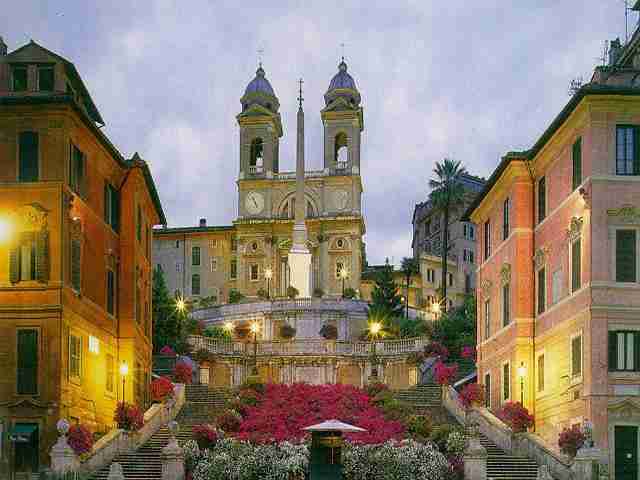
All Roads Lead To Rome

The Spanish Steps
We flew from Asheville to Atlanta to Rome on April 30 for a two-night stay before boarding our ship. This worked out beautifully because there were a few places in Rome that we had missed when we were there last year. We stayed at the Hotel Mediterraneo, which was convenient to the Metro and bus line to the Colisseum, Spanish Steps, and Trevi Fountain.
Work has recently been completed on the Colisseum, allowing visitors to walk where gladiators and lions once did battle. What a magnificent feeling it was to stand in this great arena that was built in A.D. 72. By the way, the Latin word for sand is arena, and sand was what covered the original combat area.
When we got to the Spanish Steps, known locally as Scalinata di Spagna, we were a bit overwhelmed at the size of the monumental staircase and a vision of Mount Everest popped into my mind. There were people everywhere; sitting, standing, walking, snapping photos, kissing, sleeping, eating, etc. Phyllis consulted her handy map and found what appeared to be an easier way to get to Trinita dei Monti, the church that stands at the top of the steps. Well, what appeared to be an easier route was just more steps without the view. I didn't know how my hips would take it, but I didn't travel all this way to stand at the bottom. Up we went. When we got to the top, I was huffing and puffing and aching. But the view was more than worth it! I sat on one of the steps near the top for a rest while Phyllis went off in search of a bottle of water.

Trevi Fountain
Then it was off to Fontana di Trevi. I thought there were a lot of people at the Spanish Steps -- Trevi was packed. The fountain is a very ornate series of sculptures the width of a city block. And of course there were many people standing with their backs to the fountain throwing a coin over their left shoulder with their right hand to ensure their return to Rome. The coins are removed periodically and donated to charity.
On May 3, we went by bus to Civitavecchia to board the Marco Polo. It was a great bus ride through Rome, out into the countryside, and then into the bustling port town of Civitavecchia.
And there it was -- our floating home for the next 26 days.
The Marco Polo was built by the East Germans for the USSR. It was originally named the Alexander Pushkin, classified as an "ice ship," and used for the St. Petersburg-Montreal run, crossing the north Atlantic. It is one tough ship and can handle about 750 passengers which, for us, is just right. It is an attractive ship with a blue hull and white superstructure. There is a formal dining room -- the Seven Seas -- and a buffet-style restaurant called Raffles. There were three lounges, a small casino,
library, game room, and theatre. The master is British, the officers are from various European countries, the recreation and excursion staff are British and American, and the crew (deckhands, engine room gang, waiters, stewards, etc. are mostly Filipino. It was fun trying out my limited Tagalog (one of the Filipino languages). The Marco Polo is an excellent ship in all respects. We sailed at 8 pm that evening for Livorno, Italy.

The Marco Polo

Return To The Index

Then it was off to Fontana di Trevi. I thought there were a lot of people at the Spanish Steps -- Trevi was packed. The fountain is a very ornate series of sculptures the width of a city block. And of course there were many people standing with their backs to the fountain throwing a coin over their left shoulder with their right hand to ensure their return to Rome. The coins are removed periodically and donated to charity.
On May 3, we went by bus to Civitavecchia to board the Marco Polo. It was a great bus ride through Rome, out into the countryside, and then into the bustling port town of Civitavecchia.
And there it was -- our floating home for the next 26 days.
The Marco Polo was built by the East Germans for the USSR. It was originally named the Alexander Pushkin, classified as an "ice ship," and used for the St. Petersburg-Montreal run, crossing the north Atlantic. It is one tough ship and can handle about 750 passengers which, for us, is just right. It is an attractive ship with a blue hull and white superstructure. There is a formal dining room -- the Seven Seas -- and a buffet-style restaurant called Raffles. There were three lounges, a small casino,
library, game room, and theatre. The master is British, the officers are from various European countries, the recreation and excursion staff are British and American, and the crew (deckhands, engine room gang, waiters, stewards, etc. are mostly Filipino. It was fun trying out my limited Tagalog (one of the Filipino languages). The Marco Polo is an excellent ship in all respects. We sailed at 8 pm that evening for Livorno, Italy.

The Marco Polo

Return To The Index


Return To The Index